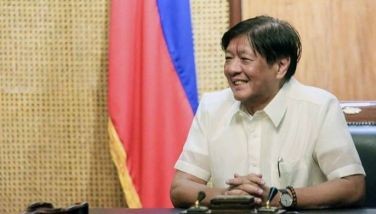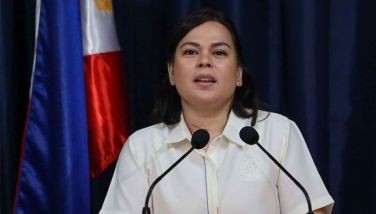$500-million bonanza in military aid from US

Apparently, there’s a huge payback for the Marcos Jr. administration after its magnanimous offer to the Americans last April to use five more Philippine military bases in addition to the previous four.
The United States can now set up their own military facilities – minibases, actually – inside nine Philippine locations, in accordance with the Enhanced Defense Cooperation Agreement (EDCA) of 2014.
They can install communication systems, store war equipment, ammunition, transport vehicles and supplies. American troops are to be stationed there on “rotational basis.” This effectively means US troops will continually be present in the country in the coming years.
Presumably in appreciation of Marcos Jr.’s show of generosity, US Secretary of State Antony Blinken and Defense Secretary Lloyd Austin announced in Manila on Tuesday that the US Congress would allocate an additional $500 million in military financing to the Philippines. They described the amount as part of an “unprecedented… once in a generation” US investment in modernizing the Armed Forces of the Philippines (AFP) and the Philippine Coast Guard (PCG).
The nine EDCA sites are: Antonio Bautista Air Base in Palawan; Basa Air Base in Pampanga; Fort Magsaysay in Nueva Ecija; Lumbia Air Base in Cagayan de Oro City; Mactan-Benito Ebuen Air Base in Cebu; Camilo Osias Naval Base and Lal-lo Airport, both in Cagayan; Camp Melchor dela Cruz in Isabela and Balabac Island in Palawan.
Three of the new sites are in Northern Luzon – the Lal-lo Airport and the naval base in Cagayan and Camp Melchor dela Cruz in Gamu, Isabela – which are proximate to the Taiwan Strait, an arena of potential armed conflict between the US and China. Marcos Jr. specifically cited the importance of Lal-lo Airport in the defense of Northern Luzon against “external threat” (subtly suggesting China).
Through a series of four bilateral discussions, dubbed as 2+2 dialogues from April 30, 2012 to April 12, 2023, the Philippines has entered into multiple defense and security alliances with a growing number of countries – bilateral, trilateral, quadrilateral alliances that the US is cobbling together to shore up its hold in the Indo-Pacific region.
Over the decades, US military financing purportedly to help modernize the AFP had typically been so minuscule as to make no impact in whatever aspect of the modernization program.
Now let’s look more closely into the implications of these developments.
One may perceive that the EDCA arrangements practically circumvent the 1987 Philippine Constitution’s prohibition on the permanent presence of foreign military bases and troops in the country. This situation calls for a thorough re-examination.
After EDCA was signed in 2014 as an executive agreement between the Philippines and the US, its constitutionality was challenged before the Supreme Court by former senators Wigberto Tanada and the late Rene Saguisag together with progressive organizations. The SC, by a 10-4 vote, however, upheld its constitutionality as an implementing agreement to the 1999 Visiting Forces Agreement (VFA) and the 1951 Mutual Defense Treaty (MDT).
The EDCA was supposedly to be effective for an initial period of 10 years, and thereafter, it shall continue in force automatically unless terminated by either party by giving one year’s notice through diplomatic channels of its intention to terminate the agreement.
In February 2016, De la Salle University professor Renato Cruz de Castro wrote that the SC ruling upholding the EDCA paved the way for “the return of forward-deployed US forces to select Philippine military bases.” Notably, he pointed out:
“The 10-year EDCA is considered a calculated effort by Manila and Washington to make the Philippines again a major staging base for projecting US naval and air power in the face of China’s maritime expansion in the South China Sea.”
On the $500-million additional funding, US Secretary of State Blinken explained that it’s intended to “boost security collaboration with our oldest treaty ally in this region, to strengthen the alliance.” The two countries’ armed forces, he added, are “working on more shared priorities in more places than ever before.” However, he did not provide any details.
It was Defense Secretary Austin who gave some details. He and Blinken, he said, are working with the US Congress to allocate the $500 million to send a “clear message of support for the Philippines from the Biden administration [which ends its term this year], the US Congress and the American people.”
The US defense department intends to more than double its investments in EDCA sites across the Philippines, with Biden asking Congress to allocate more than $128 million this year to fund key EDCA projects. Besides the DND, Austin said, the USAID plans to pre-position disaster relief supplies in EDCA sites later this year.
For the nth time, Austin reiterated that the 1951 Mutual Defense Treaty remains the “bedrock” of the US-Philippine alliance and that it applies to armed attacks on either of the two countries’ armed forces, aircraft or public vessels anywhere in the South China Sea.
Way back in 2011, such assurance was first given by former US president Barack Obama during his first official visit to the Philippines.
Local “uzi” noted that when Marcos Jr. welcomed Blinken and Austin to Malacañang on Tuesday, the three were all broadly smiling. Similarly, after a press conference following their 2+2 meeting, Blinken, Austin and their counterparts, Foreign Affairs Secretary Enrique Manalo and Defense Secretary Gilberto Teodoro Jr., put on happy faces as they joined hands for media photographers.
In welcoming the two Americans, Marcos Jr. remarked:
“I’m always very happy that these communication lines [between the treaty allies] are very open so that all the things that we are doing together, in terms of our alliance, […] the specific context of our situation here in the West Philippine Sea and in the Indo-Pacific, are continuously examined and re-examined so we are agile in […] our responses.”
The primordial consideration, of course, is how all these developments affect the lives and future of the Filipino people.
- Latest
- Trending


























